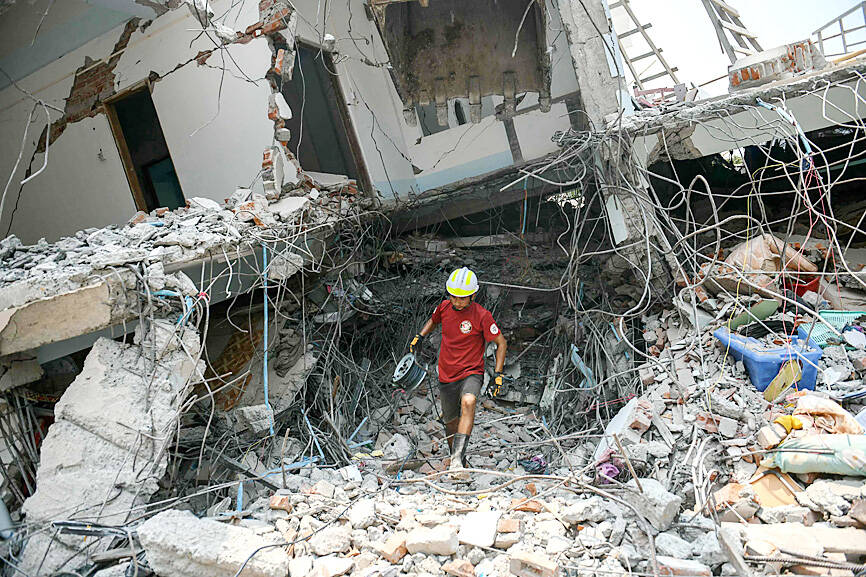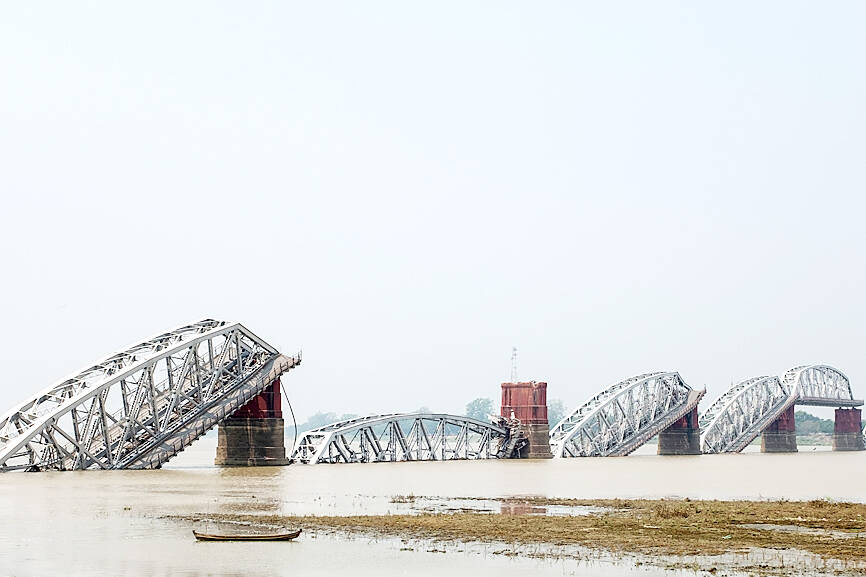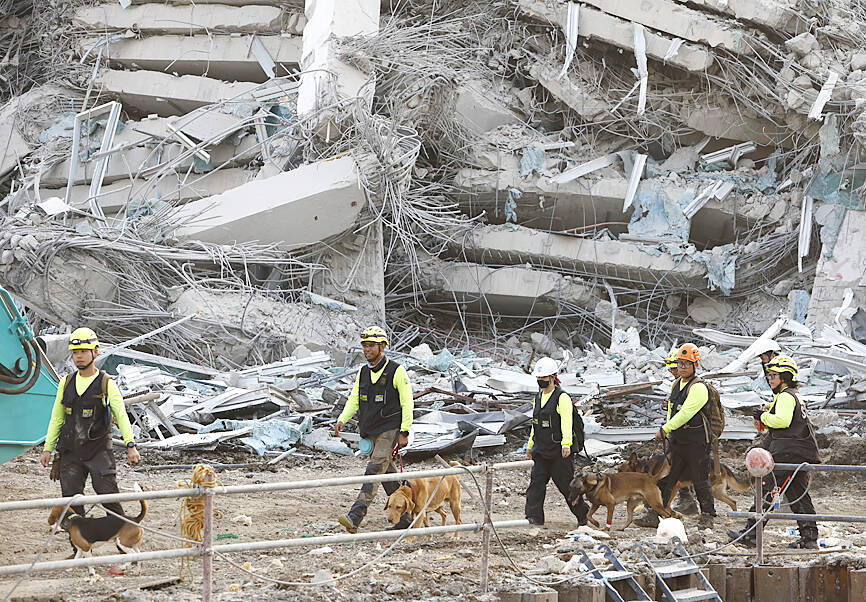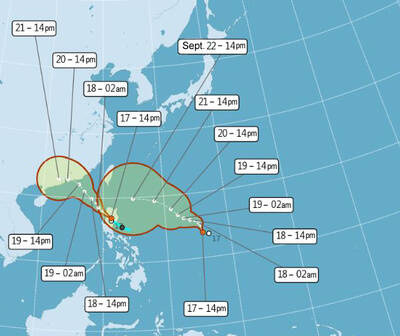The death toll from a huge earthquake that hit Myanmar and Thailand passed 1,000 yesterday, as rescuers dug through the rubble of collapsed buildings in a desperate search for survivors.
The shallow magnitude 7.7 quake struck northwest of the city of Sagaing in central Myanmar in the early afternoon, followed minutes later by a magnitude 6.7 aftershock.
The quake destroyed buildings, downed bridges and buckled roads across swathes of Myanmar, with massive destruction in Mandalay, the country’s second-biggest city and home to more than 1.7 million people.

Photo: AFP
“We need aid,” said Thar Aye, 68, a resident of Mandalay. “We don’t have enough of anything.”
At least 1,007 people were killed and about 2,400 were injured in Myanmar, with 30 more missing, the junta said in a statement.
About 10 more deaths had been confirmed in Bangkok.

Photo: EPA-EFE/STRINGER
However, with communications badly disrupted, the true scale of the disaster is only starting to emerge from the isolated military-ruled state, and the toll is expected to rise significantly.
More than 90 people could be trapped in the crushed remains of one apartment block in Mandalay, a Red Cross official said.
This was the biggest quake to hit Myanmar in decades, according to geologists, and the tremors were powerful enough to severely damage buildings across Bangkok, hundreds of kilometers away from the epicenter.

Photo: EPA-EFE
In Mandalay, Agence France-Presse journalists saw a centuries-old Buddhist pagoda that had been reduced to rubble.
“It started shaking, then it started getting serious,” a soldier at a checkpoint on the road outside the pagoda said. “The monastery also collapsed. One monk died, some people were injured, we pulled out some people and took them to the hospital.”
Guards at Mandalay Airport turned away journalists.
Damage to the airport would complicate relief efforts in a country whose rescue services and healthcare system have already been ravaged by four years of civil war sparked by a military coup in 2021.
Junta chief Min Aung Hlaing on Friday issued an exceptionally rare appeal for international aid, indicating the severity of the calamity.
Previous military governments have shunned foreign assistance, even after major natural disasters.
The country declared a state of emergency across the six worst-affected regions after the quake, and at one major hospital in the capital, Naypyidaw, medics were forced to treat the wounded in the open air.
Offers of foreign assistance began coming in, with US President Donald Trump on Friday pledging US help.
An initial flight from India carrying hygiene kits, blankets, food and other essentials landed in the commercial capital Yangon yesterday.
China said it sent an 82-person team of rescuers to Myanmar.
Aid agencies have warned that Myanmar is unprepared to deal with a disaster of this magnitude.
About 3.5 million people were displaced by the raging civil war, many at risk of hunger, even before the quake struck.
Across the border in Bangkok, rescuers worked through the night searching for survivors trapped when a 30-story skyscraper under construction collapsed, reduced in seconds to a pile of rubble and twisted metal by the force of the shaking.
Bangkok Governor Chadchart Sittipunt said that about 10 people had been confirmed killed across the city, most in the skyscraper collapse.

Taiwan is projected to lose a working-age population of about 6.67 million people in two waves of retirement in the coming years, as the nation confronts accelerating demographic decline and a shortage of younger workers to take their place, the Ministry of the Interior said. Taiwan experienced its largest baby boom between 1958 and 1966, when the population grew by 3.78 million, followed by a second surge of 2.89 million between 1976 and 1982, ministry data showed. In 2023, the first of those baby boom generations — those born in the late 1950s and early 1960s — began to enter retirement, triggering

One of two tropical depressions that formed off Taiwan yesterday morning could turn into a moderate typhoon by the weekend, the Central Weather Administration (CWA) said yesterday. Tropical Depression No. 21 formed at 8am about 1,850km off the southeast coast, CWA forecaster Lee Meng-hsuan (李孟軒) said. The weather system is expected to move northwest as it builds momentum, possibly intensifying this weekend into a typhoon, which would be called Mitag, Lee said. The radius of the storm is expected to reach almost 200km, she said. It is forecast to approach the southeast of Taiwan on Monday next week and pass through the Bashi Channel

NO CHANGE: The TRA makes clear that the US does not consider the status of Taiwan to have been determined by WWII-era documents, a former AIT deputy director said The American Institute in Taiwan’s (AIT) comments that World War-II era documents do not determine Taiwan’s political status accurately conveyed the US’ stance, the US Department of State said. An AIT spokesperson on Saturday said that a Chinese official mischaracterized World War II-era documents as stating that Taiwan was ceded to the China. The remarks from the US’ de facto embassy in Taiwan drew criticism from the Ma Ying-jeou Foundation, whose director said the comments put Taiwan in danger. The Chinese-language United Daily News yesterday reported that a US State Department spokesperson confirmed the AIT’s position. They added that the US would continue to

The number of Chinese spouses applying for dependent residency as well as long-term residency in Taiwan has decreased, the Mainland Affairs Council said yesterday, adding that the reduction of Chinese spouses staying or living in Taiwan is only one facet reflecting the general decrease in the number of people willing to get married in Taiwan. The number of Chinese spouses applying for dependent residency last year was 7,123, down by 2,931, or 29.15 percent, from the previous year. The same census showed that the number of Chinese spouses applying for long-term residency and receiving approval last year stood at 2,973, down 1,520,